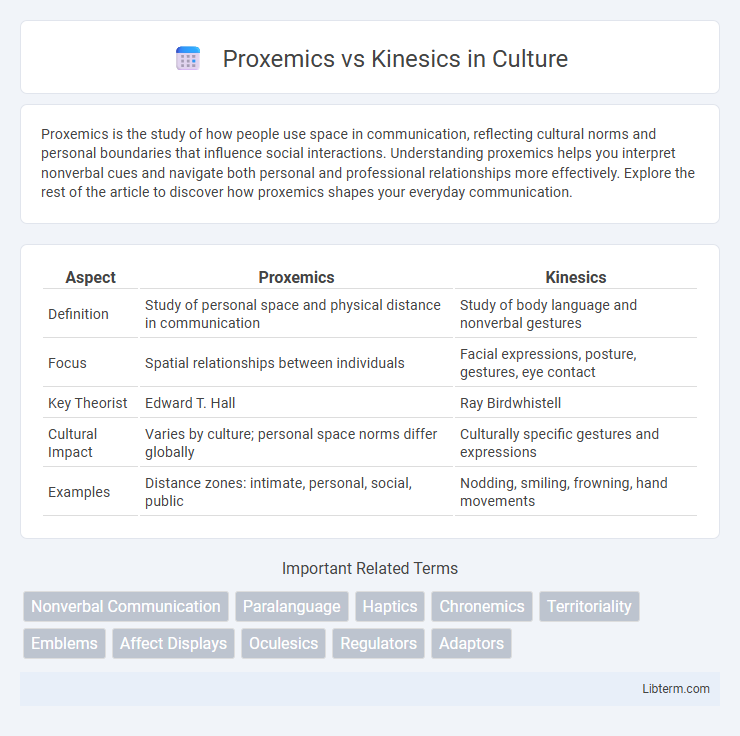Proxemics is the study of how people use space in communication, reflecting cultural norms and personal boundaries that influence social interactions. Understanding proxemics helps you interpret nonverbal cues and navigate both personal and professional relationships more effectively. Explore the rest of the article to discover how proxemics shapes your everyday communication.
Table of Comparison
| Aspect | Proxemics | Kinesics |
|---|---|---|
| Definition | Study of personal space and physical distance in communication | Study of body language and nonverbal gestures |
| Focus | Spatial relationships between individuals | Facial expressions, posture, gestures, eye contact |
| Key Theorist | Edward T. Hall | Ray Birdwhistell |
| Cultural Impact | Varies by culture; personal space norms differ globally | Culturally specific gestures and expressions |
| Examples | Distance zones: intimate, personal, social, public | Nodding, smiling, frowning, hand movements |
Introduction to Proxemics and Kinesics
Proxemics studies the use of personal space and physical distance in communication, highlighting how spatial behavior influences social interactions and cultural norms. Kinesics analyzes body language, including gestures, facial expressions, and posture, as nonverbal cues that convey emotions and intentions. Understanding both proxemics and kinesics is essential for interpreting the full context of human communication beyond spoken words.
Defining Proxemics: The Language of Space
Proxemics, defined by anthropologist Edward T. Hall, studies the use of space in communication, examining how physical distance influences social interactions and personal boundaries. Unlike kinesics, which interprets body movements and gestures, proxemics analyzes spatial relationships such as intimate, personal, social, and public distances to convey meaning non-verbally. Understanding proxemics provides crucial insight into cultural norms, interpersonal dynamics, and the unspoken language of spatial behavior.
Understanding Kinesics: The Power of Body Language
Kinesics, the study of body language, reveals how facial expressions, gestures, and posture communicate emotions and intentions beyond spoken words. Understanding kinesics enables individuals to interpret nonverbal cues effectively, enhancing interpersonal communication and reducing misunderstandings. This contrasts with proxemics, which examines the use of personal space and physical distance in social interactions.
Key Differences Between Proxemics and Kinesics
Proxemics studies the use of space and distance in communication, focusing on how physical proximity affects interpersonal interactions, while kinesics examines body language, including gestures, facial expressions, and posture. Proxemics emphasizes spatial relationships and territoriality, whereas kinesics analyzes nonverbal cues that convey emotions and attitudes. Understanding these distinct aspects enhances the interpretation of nonverbal communication in social and cultural contexts.
Cultural Variations in Proxemics
Cultural variations in proxemics significantly influence how individuals perceive personal space during communication, with some cultures valuing close physical proximity while others prefer greater distance to maintain comfort and respect. In Latin American and Middle Eastern societies, people often stand closer during conversations, reflecting warmth and friendliness, whereas Northern European and East Asian cultures typically maintain larger personal bubbles to convey formality and privacy. Understanding these cultural differences in proxemics is crucial for effective cross-cultural communication and avoiding misunderstandings related to spatial behavior.
Cultural Impact on Kinesics
Kinesics, the study of body language, gestures, and facial expressions, varies significantly across cultures, influencing communication and social interactions worldwide. Cultural norms dictate the interpretation of nonverbal cues, where a gesture considered respectful in one culture might be offensive in another. Understanding these cultural differences in kinesics is crucial for effective intercultural communication and avoiding misunderstandings.
Proxemics in Everyday Communication
Proxemics studies the use of personal space and physical distance in everyday communication, influencing comfort levels and social interactions. Understanding proxemic zones such as intimate, personal, social, and public distances helps interpret nonverbal cues and manage interpersonal dynamics effectively. Unlike kinesics, which focuses on body movements and gestures, proxemics emphasizes spatial relationships as a critical component of communication.
Kinesics in Social Interactions
Kinesics, the study of body language and nonverbal communication, plays a crucial role in social interactions by conveying emotions, intentions, and social cues through gestures, facial expressions, posture, and eye contact. Unlike proxemics, which examines spatial relationships and physical distance, kinesics enhances communication by providing context and emotional depth beyond spoken words. Understanding kinesics improves interpersonal connections, aids in conflict resolution, and strengthens rapport in both personal and professional settings.
The Role of Context in Proxemics and Kinesics
Proxemics analyzes spatial relationships and physical distance in communication, heavily influenced by contextual factors such as culture, setting, and social norms that dictate acceptable personal space. Kinesics studies body language, including gestures, facial expressions, and posture, which vary in meaning depending on situational context and interpersonal dynamics. Understanding the role of context is crucial for accurately interpreting both proxemic and kinesic cues, as the same behavior can convey different messages across environments and cultural backgrounds.
Integrating Proxemics and Kinesics for Effective Communication
Integrating proxemics and kinesics enhances effective communication by combining spatial awareness with body language cues, allowing for a richer understanding of interpersonal interactions. Proxemics analyzes personal space and physical distance preferences, while kinesics interprets gestures, facial expressions, and posture, together providing a comprehensive nonverbal communication framework. Mastery of both allows communicators to convey emotions, intentions, and social dynamics more accurately in diverse cultural contexts.
Proxemics Infographic

 libterm.com
libterm.com